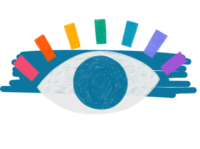Pediatric ophthalmologists often encounter young patients with a condition known as strabismus, commonly referred to as a “squint” or “crossed eyes.” Strabismus is a misalignment of the eyes, and it can affect a child’s vision and overall eye health. In this blog post, we will explore what strabismus is, its causes, the signs and symptoms to watch for, and available treatment options.
What is Pediatric Strabismus (Squint)?
Strabismus is a condition where one or both eyes do not align properly with each other. It can occur intermittently or continuously and may involve one eye turning inwards, outwards, upwards, or downwards. Strabismus can be present in infants, toddlers, or older children and requires prompt evaluation and management by a pediatric ophthalmologist.
Causes of Pediatric Strabismus:
The causes of strabismus in children can be multifactorial and may include:
- Muscular Imbalance: Problems with the eye muscles can lead to misalignment.
- Family History: A family history of strabismus may increase the risk.
- Refractive Errors: Uncorrected nearsightedness, farsightedness, or astigmatism can contribute to strabismus.
- Neurological Conditions: Some neurological conditions, such as cerebral palsy, may increase the likelihood of strabismus.
Common Signs and Symptoms:
Identifying strabismus in children can be relatively straightforward, as it often presents with the following signs and symptoms:
- Misaligned Eyes: One or both eyes visibly turn inwards, outwards, upwards, or downwards.
- Double Vision: Older children may experience double vision when their eyes are misaligned.
- Squinting: Children may squint or close one eye to try to improve their vision.
- Poor Depth Perception: Strabismus can affect depth perception and hand-eye coordination.
Diagnosis:
A pediatric ophthalmologist can diagnose strabismus through a comprehensive eye examination, which may include:
- Assessment of eye alignment.
- Measurement of refractive errors.
- Evaluation of eye muscle function.
- Examination of visual acuity.
- Assessment of the child’s ability to focus and coordinate their eyes.
Treatment Options:
The treatment approach for pediatric strabismus depends on the severity of the condition, the child’s age, and its underlying causes. Common treatment options include:
- Prescription Glasses: Correcting any refractive errors with prescription glasses may help alleviate strabismus in some cases.
- Eye Patching: Patching the stronger eye can encourage the weaker eye to develop better vision.
- Vision Therapy: Vision therapy exercises and activities can help improve eye coordination and strengthen eye muscles.
- Eye Drops or Medication: In certain cases, eye drops or medications may be prescribed to temporarily blur the vision in the stronger eye, forcing the weaker eye to work harder.
- Surgery: When non-surgical treatments are ineffective, surgical intervention to correct the alignment of the eye muscles may be necessary.
Conclusion:
Pediatric strabismus is a condition that requires prompt evaluation and treatment to prevent potential long-term vision problems and social challenges for the child. If you suspect your child has strabismus or if you notice any signs and symptoms, consult a pediatric ophthalmologist for a comprehensive examination and expert guidance on the best course of action. Early intervention can help ensure your child’s visual development and overall eye health.
